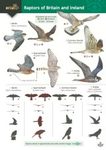By
Keith
28 Oct 2020
Written for Hardback
The Snowy Owl needs little introduction, even to non-birding audiences. This is partly down to Hedwig, Harry Potter’s pet Snowy Owl, but also because it is such a stunning bird. So it came as quite a surprise that this is the first serious book to be published about the species.
This the latest in the long-running series of Poyser monographs, and in some ways it is quite different to its predecessors. Many of the earlier Poyser books were written by people who had devoted their lives to their chosen species (Bryan Nelson on the
Gannet, Derek Ratcliffe on the
Peregrine, Donald Watson on the
Hen Harrier) while this book is written by two raptor enthusiasts with a huge knowledge of the wildlife beyond the Arctic Circle. In this book, they have undertaken a massive literature review (much it in Russian) to put in one place everything that anyone knows about Snowy Owls.
With a distribution from Canada and Greenland across to Scandinavia and Russia the Snowy Owl is widespread, but interestingly it is clear that much less is known about the birds present on the west side of the Atlantic compared to the east side. The authors start by explaining the basic facts about the species and then move on to describe the breeding range in detail, followed by palaeontology, systematics and evolution. The difference between winter and summer habitats is explained and many pages are devoted to information about breeding and the timing of hatching. There are also sections on diet, numbers and population density. The birds can wander quite widely in winter so there is a specific chapter on winter range and records. The birds interact with humans in those winter months much more than at the time of breeding the book records how these can be friends or foes.
The text is somewhat heavy at times but is supported by attractive drawings by Jackie Garner and a wide range of photographs. Most of these are good but a number by the authors fall below the levels that I would accept – for example, those on pages 84 and 103 (both supplied by the authors). However, if you need to know all that has been published about the Snowy Owl it is all here and well organised.





















































